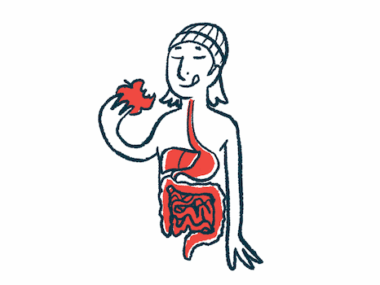Swallowing problems may be due to poorer sensation in the airways
Small study finds no major problems in issue of importance due to dysphagia
Written by |

Major problems with sensation in the airways — essential in preventing the dysphagia or swallowing difficulties that can lead to complications like aspiration pneumonia — were not observed between Parkinson’s disease patients and healthy adults in a small recent study.
But given the proposed relationship between airway sensory impairments and dysphagia, a common Parkinson’s symptom, its researchers consider it important to evaluate airway sensory status in Parkinson’s, possibly with a more sensitive technique than that used in this work. They also favored larger studies in this area.
“A routine clinical examination of the sensory input of PD [Parkinson’s disease] participants is a must since dysphagia is one of the main symptoms of the disease,” the researchers wrote. “Protective reflexes are paramount to airway protection. … [and] recent studies have demonstrated that airway protection mechanisms are negatively affected in PD.”
The study, “Assessment of the Sensitivity of the Vocal Tract in Parkinson Disease by Nasal Video Endoscopy,” was published in the International Archives of Otorhinolaryngology.
Swallowing problems pose risks to people with Parkinson’s disease
Dysphagia can pose serious safety concerns for Parkinson’s patients, from a risk of malnutrition or dehydration to choking and aspiration pneumonia, a potentially life-threatening infection caused by food or liquids being inhaled into the respiratory tract instead of swallowed.
When food is swallowed, it travels down the pharynx (throat area) to reach the digestive system. The air we breathe also passes through the pharynx to enter the lower airways. The larynx, also known as the voicebox, is an upper airway component critical for protecting against food accidentally taking a wrong path into airway structures.
Proper swallowing depends highly on sensory inputs to these structures. Such inputs trigger complex reflexes that ensure air goes one way and food goes the other.
Evidence suggests that reduced sensitivity in the larynx may contribute to a failure of these protective mechanisms, leading to food aspiration in Parkinson’s, according to the scientists, all with the Universidade Federal do Rio Grande do Sul in Brazil.
“It is important to conduct several studies and develop a valid, practical, and reliable method to identify airway protection deficits,” they wrote.
Researchers used a technique called fiberoptic endoscopic evaluation of swallowing (FEES) to look into the anatomy of the upper airways, swallowing function, and airway sensitivity in 12 adults with a Parkinson’s diagnosis being followed at a hospital’s neurology center in Porto Alegre. Twelve healthy age- and sex-matched adults from the community were included as controls; both groups consisted of seven men and five women.
In FEES, a small optical fiber is inserted into the nasal cavity, enabling the visualization of the pharynx and larynx during certain behaviors, such as swallowing. The fiber also can be used to stimulate different areas via a gentle touch, assessing a person’s reflexive response (e.g., coughing or gagging) as a test of sensitivity.
Study participants, with an average age of about 63, underwent the procedure after answering a questionnaire about their perceived swallowing abilities.
No anatomical abnormalities in the nasal cavity or pharynx were observed in either group, and the larynx’s ability to produce speech sounds was unaffected.
Six Parkinson’s patients were considered at risk for dysphagia based on their responses to the questionnaire, and all had evidence of swallowing difficulties in the FEES assessment. Of the six not thought at risk based on responses, two showed evidence of dysphagia with FEES.
Swallowing was assessed with a liquid, a purée (thicker paste or liquid), and a solid food.
Food spilling from the mouth was most often seen in patients
The most common issue with swallowing among patients — regardless of food consistency — was food spilling from the mouth rather than being swallowed; it was seen in 10 patients with a liquid, nine with a solid, and four with a purée food. This was followed by pharyngeal residue, where food remains in the pharynx after swallowing, found in seven patients with solid food, four with a liquid, and three with a purée.
When swallowing a liquid, laryngeal penetration, or food entering the larynx, was seen in three patients, and aspiration, where food enters the lower airways, was seen in one. These swallowing issues were not found to be significantly related to laryngeal sensitivity.
Airway sensitivity differed between Parkinson’s patients and controls in one area, called the arytenoid cartilages, which are important for producing vocal sounds. Patients showed a lower sensitivity than did healthy adults.
A heightened sensitivity among control participants also tended to be seen in other areas, but group differences did not reach statistical significance.
Still, “results indicate a more preserved sensitivity in the [control group] compared to the [patient group], suggesting that sensitivity disorders are more present in participants with PD,” the researchers wrote.
They noted that FEES might not be the most sensitive technique for evaluating airway sensitivity. This study’s “low level of significance” between patients and healthy adults also might be due to the study’s small sample size and the inclusion of patients with less severe disease.
“We suggest that future investigations with larger samples of PD participants should be considered, as well as the disease staging [severity stratification], to follow-up the progression of the dysphagia related to PD severity and its [distinct] stages,” the team concluded.






